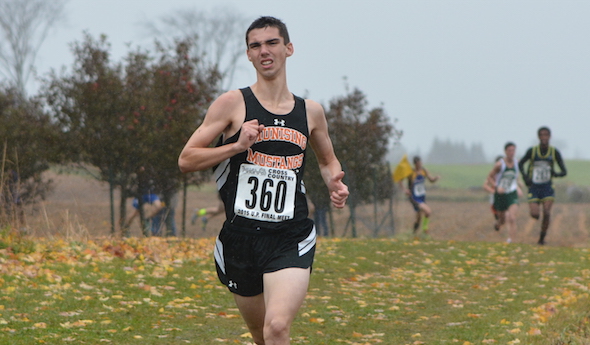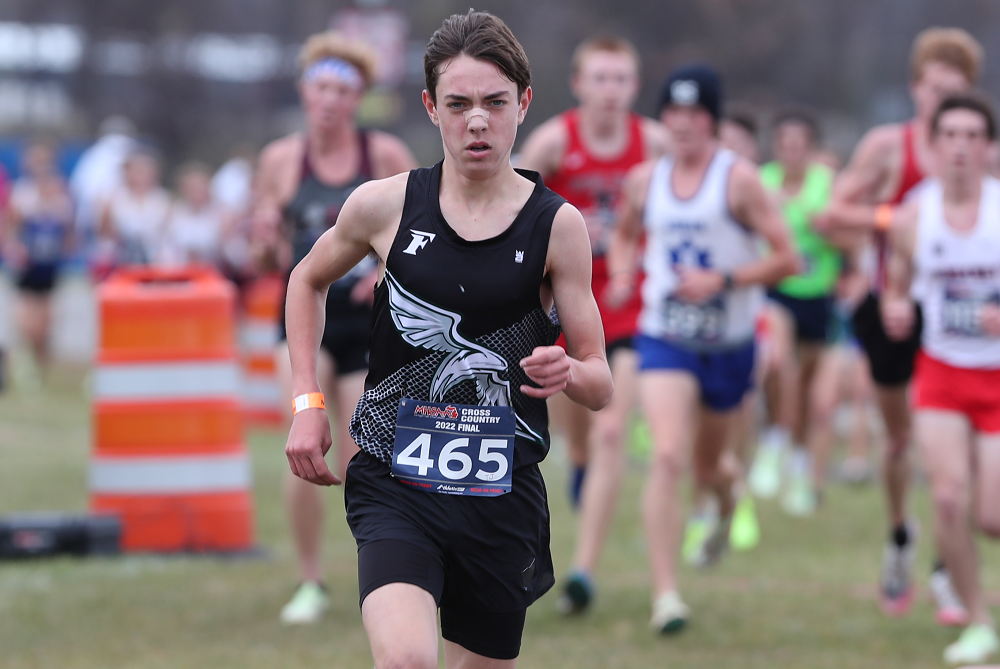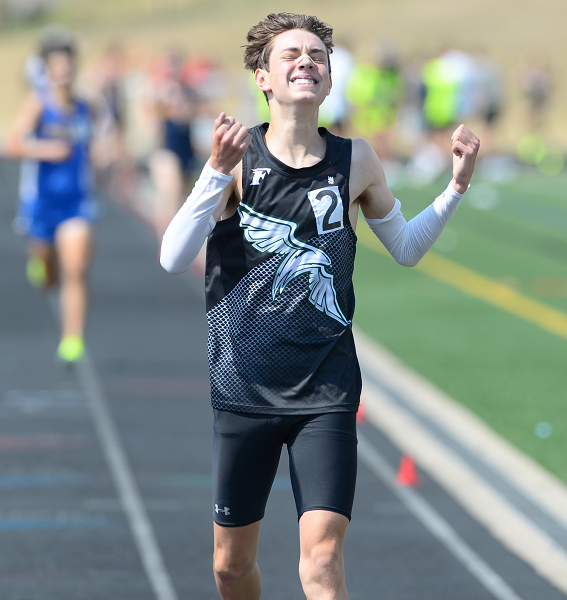
Negaunee Tops D1; D2-3 Champs Repeat
By
John Vrancic
Special for MHSAA.com
October 25, 2015
FLAT ROCK — Thirty-two years had passed since a Negaunee boys cross country team was last crowned Upper Peninsula champion.
The Miners, who were competing in Class C in 1983, changed that Saturday by earning their first Division 1 title in convincing fashion with 43 points.
 Negaunee, which finished the season undefeated, was followed by Sault Ste. Marie at 85, Marquette at 93, Houghton at 110 and Escanaba with 115 points.
Negaunee, which finished the season undefeated, was followed by Sault Ste. Marie at 85, Marquette at 93, Houghton at 110 and Escanaba with 115 points.
“Our guys really wanted it,” said Negaunee coach Lisa Bigalk. “They went out and attacked. This was such an incredible season. The guys didn’t have an off day all year. This is a real close team. They stayed together and helped each other through. Hopefully, this will help us attract more guys into our program. This should motivate them for next season.”
Marquette senior Lance Rambo won the individual title for the second time in three years, covering the 3.1-mile course in 16 minutes, 11 seconds at Beauchamp’s Grove in rural Delta County.
He was followed by Negaunee sophomore Colton Yesney in a personal-best 16:32.5 and Escanaba junior Joey Wolfe (16:49.4)
“I probably could have gone a little faster, but I just wanted to absorb everything in the last half-mile,” said Rambo. “Colton ran a great race. He was so happy to get second and Logan (Zueger) really stepped up for us. … Our team didn’t have its best race, but I love this course. I really appreciate Gladstone putting on this meet.”
 Kingsford senior Nate Carey, who came in as defending champ, took fourth this time (16:52). He was followed by Calumet’s Mitch Delong (16:52.3), Zueger (17:06) and Negaunee’s Ethan Wallner (17:09).
Kingsford senior Nate Carey, who came in as defending champ, took fourth this time (16:52). He was followed by Calumet’s Mitch Delong (16:52.3), Zueger (17:06) and Negaunee’s Ethan Wallner (17:09).
“I’ve had a great four years and a great season overall,” said Carey. “Lance is the best runner in the U.P. right now. The top five runners were tough.
“I was running today for Mia Dalner (Iron Mountain seventh-grader) who had medical issues and passed away last week.”
Division 2
Ishpeming, placing five runners among the top eight, retained its title with 28 points. Gogebic edged Powers North Central 61-62 for the runner-up trophy. Fourth-place Ironwood had 81, followed by Hancock with 133.
Gogebic senior Sam Dean earned his first individual title in 17:14.8, followed by Ishpeming freshman Spencer Giroux (17:22.5), Ironwood freshman Nick Niemi (17:30.4), North Central senior Bryce Holle (17:58.3) and Ishpeming’s Derek Mahoski (18:11.9).
“I wanted to go out with the fast group to see what that was going to be like today,” said Dean. “You just have to go out hard and hang on. In the last mile, the wind picked up and the rain came down hard, which made it a challenge. I just needed to be strong and go for the win. It feels good to win this race and for our team to take runner-up. Most of the race was good, but the course was muddy in different spots and it got chewed up a little.”
 Niemi had similar thoughts.
Niemi had similar thoughts.
“Getting a fast start was a key,” he said. “You have to get out fast and settle into a pace. The temperature (in the mid 50s) was real nice, but it started to get windy and the rain was coming right at you. My goal was to get into the top five, and I ended up with a personal-best time.”
Ishpeming junior Daren Giuchin, who helped the Hematites beat Gwinn in football Friday night, became the first gridder to place in the Division 2 Final.
“It’s crazy and tiring,” said Guichin, who took sixth in 18:17.3. “I didn’t think I’d be able to do it because I’m a little banged up from last night, but I came through.”
Division 3
Chassell became a repeat winner with 51 points, followed by Dollar Bay with 69, Cedarville 96, Munising 134 and Stephenson 141.
Munising senior Brett Hannah retained his title (16:52.3) after also winning as a freshman in 2012 and senior Michael Brown recorded the highest finish ever for a Marquette North Star Academy runner by taking second in a personal-best 17:48.5.
Chassell’s Abraham Gockenbach was third (17:54.5), followed by Dollar Bay’s Brendan LeClaire (18:10) and Jacob Iacono (18:10.7).
“Our boys and girls winning for the second straight year is absolutely great for our program,” said Chassell coach Marco Guidotti. “The kids ran for each other. We’ve been back and forth with Dollar Bay all year, our girls especially. We knew it wasn’t going to be easy, but the kids worked together and made it happen for themselves.”
The MHSAA Cross Country Finals are sponsored by the Michigan National Guard.
PHOTOS: (Top) Munising's Brett Hannah breaks away from the Division 3 pack to claim his second individual title in four seasons. (Middle) From left, Escanaba's Joey Wolfe, Negaunee's Colton Yesney and Marquette's Lance Rambo were the top finishers in Division 1. (Below) Gogebic's Sam Dean rounds a bend on the way to winning the Division 2 title. (Photos by Cara Kamps.)

Freeland's Hansen Not Focused on Joining All-Time Greats - But On His Way
By
Paul Costanzo
Special for MHSAA.com
September 29, 2023
The goal written on Matt Kaczor’s Post-It Note was sub-15 minutes, 15 seconds. That’s what the Freeland cross country coach was hoping for from star runner TJ Hansen during his junior season.
 Kaczor tore it up after seeing Hansen run a single race this fall.
Kaczor tore it up after seeing Hansen run a single race this fall.
“Knowing what he did over the summer and where he was at, seeing what his 1,600 (meter) and his mile got down to, I had a feeling he could get under 15:30 quickly,” Kaczor said. “After the first race, I looked at my assistant and was like, ‘I’ve gotta rip up that Post-It Note. I don’t think our goal is on the level of where he’s at right now.’ At first, it was break 15:15. Once I saw him race at the Under the Lights (on Aug. 18 at St. Johns), I was like, ‘Yeah, he’s going sub 15.’”
Hansen ran 15:39.6 in that first race, and on Sept. 7, in Shepherd, he ran 15:13.9 to meet the goal written on the now-shredded Post-It Note.
This past Saturday, he ran 15:03.7 at the Cadillac Veterans Serving Veterans Invitational. It’s the fastest time recorded in Michigan this year, and a signal that Kaczor might be filling out a new Post-It Note before the season is out.
“The sub-15 barrier, that’s been something on my mind for a while,” Hansen said. “Now that I’m edging closer and closer to that, it’s been exciting. With how heavy my training has been, I wouldn’t expect (to have run this fast this early). Being able to run the times I am really paints the picture for what’s ahead.”
Hansen came into the season already regarded as one of the elite distance runners in the state. He won the 3,200 meters at the MHSAA Lower Peninsula Division 2 Track & Field Finals this past spring. He’s also finished all-state (12th and fifth, respectively) the past two seasons at the LPD2 Cross Country Finals.
His current trajectory, however, would put his name near some of the state’s all-time greats. But that’s not something Hansen is focusing on.
“I really don’t like to compare myself to others,” he said. “I don’t focus on that. I try to be the best TJ Hansen that I can be. The best version of myself.”
Focusing on himself is almost necessary for Hansen, as he’s spending a lot of time during his races running by himself.
At each of the big events Freeland has run in this season, Hansen has finished at least 20 seconds ahead of his nearest competitor. That includes all divisions of the Duane Raffin Festival of Races in Holly.
In Cadillac, where Hansen ran his current best time, he was a full minute ahead of the rest of the field.
 “He’s just a special athlete,” Kaczor said. “I can’t see Freeland having someone like this in a while. He’s a generational talent. What’s crazy is, I had the school record when he was a freshman. He and Braden (Honsinger) broke it last year. But TJ has now dropped that school record (set in 1998) by almost a minute.”
“He’s just a special athlete,” Kaczor said. “I can’t see Freeland having someone like this in a while. He’s a generational talent. What’s crazy is, I had the school record when he was a freshman. He and Braden (Honsinger) broke it last year. But TJ has now dropped that school record (set in 1998) by almost a minute.”
Hansen’s achievements have already put him on a path to run at the next level, which is something of a family tradition.
His older sisters Peyton and Kiera are track & field athletes at Wayne State and Eastern Michigan, respectively. Their parents, Tim and Pam, were track & field stars at Central Michigan.
TJ has drawn the attention of coaches around the country, including from Michigan, Michigan State, Wisconsin, Tennessee and Colorado.
Having family members who know the process is a help for Hansen, and he said they’ve all been good about allowing him to choose his own path, whatever that may be.
“He’s from a good family that knows how to work and knows how to get things done,” Kaczor said. “He knows that if he puts in the work, he’s going to be at a good spot.”
While Hansen admits it can be a bit overwhelming, he’s using it as motivation to run faster and continue to put his name out there.
Also serving as motivation is 2022 Division 2 champion Connell Alford of Chelsea. Alford is among the elite group of runners in Michigan who have broken the 15-minute mark, doing it twice a year ago.
He currently has the state’s second-best time behind Hansen’s this year, running 15:09.1 at the MSU Invitational on Sept. 15.
“Whenever I see him drop a time, my main goal is to run faster,” Hansen said. “Whenever I see him run a good time, that motivates me to work hard.”
The two won’t see each other until the MHSAA Finals on Nov. 4 at Michigan International Speedway. It’s an opportunity Hansen is excited for, as it’s a chance to race and be pushed toward the lofty goals he’s set for himself. Kaczor is excited about it, too, even if it might mean having to replenish his supply of Post-Its.
“We don’t talk about winning the state title; we talk about making sure that we have great races on those days,” Kaczor said. “We can’t control how somebody else runs. It’s a matter of can we, if the weather is right and the course is in good condition, can we be one of the few guys that has run in the 14s on that course? That’s the goal. Put yourself in some great categories with those upper echelons and the greats of all-time.”
 Paul Costanzo served as a sportswriter at The Port Huron Times Herald from 2006-15, including three years as lead sportswriter, and prior to that as sports editor at the Hillsdale Daily News from 2005-06. He can be reached at [email protected] with story ideas for Genesee, Lapeer, St. Clair, Sanilac, Huron, Tuscola, Saginaw, Bay, Arenac, Midland and Gladwin counties.
Paul Costanzo served as a sportswriter at The Port Huron Times Herald from 2006-15, including three years as lead sportswriter, and prior to that as sports editor at the Hillsdale Daily News from 2005-06. He can be reached at [email protected] with story ideas for Genesee, Lapeer, St. Clair, Sanilac, Huron, Tuscola, Saginaw, Bay, Arenac, Midland and Gladwin counties.
PHOTOS (Top) Freeland's TJ Hansen leads a pack during last season's LPD2 Final at Michigan International Speedway. (Middle) Hansen enjoys a moment of exhilaration after winning the 3,200 this spring at the LPD2 Finals at Ada Forest Hills Eastern. (Top photo by Carter Sherline/Run Michigan; middle photo by Dave McCauley/Run Michigan.)

